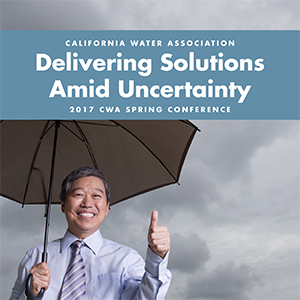At its April 7, 2015, meeting, the State Water Resources Control Board (SWRCB) announced a proposed regulatory framework and subsequently, at its May 5, 2015, meeting, unanimously passed Resolution 2015-0032 implementing Governor Jerry Brown’s April 1 Executive Order B-29-15, which mandated a statewide 25 percent reduction in water use. These updated emergency conservation regulations were ratified by the Office of Administrative Law on May 18.
For its part, the California Public Utilities Commission (CPUC) passed two resolutions, Resolution W-5034 on April 9, 2015, and Resolution W-5041 on May 7, 2015. Both directed the water utilities under its jurisdiction to comply with all of the mandatory water conservation measures in the SWRCB’s Resolutions 2015-0015 and 2015-0032, which have been codified in Title 23, Sections 863/864/865/866 of the California Code of Regulations. Details on the emergency conservation regulations can be found in the Emergency Water Conservation Regulations Portal on the SWRCB’s website.
The CPUC’s resolutions ordered the water utilities to notify their customers of the new emergency regulations through notices in local newspapers or other distribution channels such as social media, email, text messages, company websites or bill inserts. The resolutions also required the water utilities to implement the revised and expanded regulations approved by the SWRCB, including the new “conservation standards” whereby different geographical regions in the state must reduce water use compared with the same period in 2013 between a range of 8 percent and 36 percent. The logic behind the conservation standards is that the overall state average achieved through the varied reduction targets will meet the mandated 25 percent reduction statewide.
According to the CPUC press release announcing compliance with the governor’s mandate, the larger water investor-owned water utilities (IOUs) must take steps to ensure that their respective water-use reduction targets can be achieved. Smaller IOUs with districts having less than 3,000 service connections must reduce water use by 25 percent by restricting outdoor irrigation to no more than two days per week or implement other mandatory restrictions to achieve the necessary water savings. An earlier CPUC press release directed the water IOUs to:
- Inform their customers of their implementation plan for outdoor irrigation restrictions. Specifically, if a water company does not already have a limit on the number of days that outdoor irrigation of ornamental landscapes or turf with potable water is allowed, the company must limit such irrigation to no more than two days per week.
- Inform customers that they are prohibited from irrigating turf or ornamental landscapes during and 48 hours following measurable precipitation.
- Notify customers when the water company is aware of leaks that are within the customer’s control.
- Inform commercial businesses that restaurant and other food service providers can only serve water to customers on request and that hotel/motel operators must provide guests with the option of choosing not to have towels and linens laundered daily and prominently display notice of this option.
Violations of these prohibited actions are punishable by a fine of up to $500 for each day in which the violation occurs.
“The regulated water utilities fully endorse the CPUC’s directives in Resolutions W-5034 and W-5041 because they will enable the IOUs to comply with the SWRCB’s emergency conservation regulations and take a big step forward in achieving the governor’s 25 percent reduction mandate,” said CWA Executive Director Jack Hawks. “Since water utilities, alone, cannot comply with the water use reduction mandates, they will need to partner with their customers. This will require significant decreases in customers’ water use, an essential element to achieving compliance.”
In anticipation of the SWRCB’s adoption of the new emergency regulations on May 5, the CPUC added an additional requirement in Resolution W-5034 for its Class A and B water utilities (those with more than 2,000 service connections) to add Schedule 14.1 to their existing Tariff Rule 14.1, which implements their water shortage contingency plans. Unlike Tariff Rule 14.1, which addresses “voluntary” conservation measures and mandatory water use “restrictions,” Schedule 14.1 implements mandatory water use “reductions.” Among other things, Schedule 14.1 will include penalties for violating prohibited and non-essential water uses, as well as drought surcharges for exceeding the utility’s specific water use reduction target, as identified by the SWRCB in its regulatory framework tiers.
To implement Schedule 14.1, the water utilities are required to design the structure of the mandatory reduction schedules and the penalties and surcharges necessary to stimulate water use reductions. The utilities then must seek the CPUC’s approval through a formal filing of the language, structure and issuance of their Schedule 14.1. During this process, they are required to hold public meetings with their customers to explain the details and ramifications of Schedule 14.1. Additionally, activation of the reduction plan must comply with all requirements of Sections 350-358 of the California Water Code. The filings and public meetings are expected to take place by June 1, 2015.





